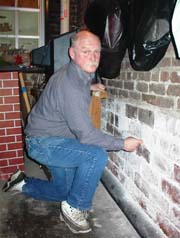|
One
item high on the list is an auditorium for plays, speech, music,
graduation and community programs – an auditorium which could be
used not only by Central but by all the schools in the district.
The only room in the school that can hold a group of any size
is the basement gym, which is not even big enough to hold the
parents of all the school’s 270 students.

[Principal Lenny Janet standing next to
the old, cracked walls of Central School]
“If
we are having a program, we have to break it down to primary or
elementary students, and even then some parents have to stand,”
said Central School Principal Lenny Janet.
“And it’s always hot, so we want to get the program over
fast.” The gym does
not have adequate ventilation and the windows cannot be opened.
There is no seating area around the gym, so graduation
ceremonies have to be held at the junior high school.
Although
the gym has many drawbacks, it is still in constant use every day.
Because there is no other place for the students to eat
lunch, it serves as a lunchroom, with students carrying their trays
down a flight of stairs from the cafeteria to tables in the gym.
Before school it is the place for band practice.
The
Central School teachers would like to see a cafeteria separate from
the gym, with up-to-date equipment and an eating area on the same
level. They would
also like to have a place where students can go during inclement
weather before school and during inside recesses.
“In the morning we can’t put them in the gym because of
band lessons, so they are either in the hallways or in the library.
In bad weather, there is no place for the kids,” Janet
said.

[Terry Thompson, custodian for Central School,
kneeling next to a wall that is falling apart]
Climate
control, including a heating system that can be regulated in each
classroom, air conditioning and screens for the windows, is also
high on the list. Central
School has no air conditioning, and although many windows do open
(some do not), there are no screens.
Janet noted that on the upper floors, especially on the south
side of the building, the temperature has been known to reach 109
degrees. “In August, September and October, many days are
intolerable,” he said.
The
school’s steam heat, with the original radiators in each room, is
provided by a boiler housed in a separate small building. This
building was constructed in 1869 to serve the original Central
School, which sat on the back of the same lot and faced Seventh
Street. Once
fired by coal, the boiler is now gas-fired, but it is difficult to
repair and not always dependable.
“We
cross our fingers that it will keep running,” said Terry Thompson,
custodian. “In the
winter we run a kerosene heater in there so the pipes don’t
freeze.”
Although
some adjustments can be made to the radiators, teachers on the south
side of the building say they cannot turn the heat down enough to
keep the rooms from being uncomfortably hot and must open windows
even on winter days.
More
space for the variety of activities essential to education today is
also on the teachers’ wish list. Many activities are provided by itinerant teachers who travel
from school to school. While
they do not spend all their time at Central, these teachers would
like to have a room there for their equipment and activities.
At
present, music instruction is held in a converted locker room, and
the band has to go to the gym to practice.
The art teacher must bring materials to each classroom and
has no central place to store them. Other itinerant staff include physical education teachers,
the speech therapist and the guidance counselor.
Space
is needed, too, for counseling, conferences, and Special Education
staffings, as well as other confidential meetings, teachers say.
Because
Central School houses about 35 Special Education students, including
behavior disorder students, staffings must be held regularly.
These conferences may include from 10 to 20 people and must
be kept confidential. The
only meeting space available for the staffings are the teachers’
workroom or the library, rooms which are in high demand for other
purposes, so the Central staff has also included in its wish list an
office for the Tri-County Special Education personnel with its own
private restroom. Teachers
would also like to give the Special Education staff a “timeout”
room separate from the classrooms.
|
Restrooms
are an important item on the wish list, too.
The only restrooms in the building are the students’
restrooms, so “adequate restrooms and plenty of them” are
wanted. Teachers would
like to see primary classrooms have sinks so students could wash up
after messy projects, and they would like their kitchen staff to
have convenient restrooms, too.

Another
private space on the wish list is a separate sickroom near the main
office. At present, a
sick child must lie on a cot in the hall outside the principal’s
office. Teachers say
sick children need privacy, and a special room would also reduce
exposure to others.
A
library and/or media center with adequate shelf space so books can
be kept low and smaller children do not need to stand on a stool to
reach them is another item on the list. The library could also be used as a meeting room, the
teachers say.
Telephones
on each building level, with private places for teachers to hold
phone conferences with parents, is another wish, along with phones
in every classroom, for security purposes.
At present, the school has a telephone in Janet’s office,
one in the kitchen and one in the teachers’ workroom.
These phones do not give teachers privacy when talking to
parents, Janet said.
Accessibility
is a must, according to teachers, not just for students with special
needs but also for family members who might need to use a cane or
wheelchair. At the
present time, anyone who enters the school must go either up or down
a flight of stairs. An
elevator would be welcome.
Teachers
would like a state-of-the-art telecommunications lab where students
can see and hear teachers and speakers from anywhere in the world.
The school does have an excellent computer lab which was
updated this year and has 20 computers, Janet said.
However, the electrical setup of the school is now at maximum
capacity and no more equipment can be added, he said.

[Children have to walk down a flight of stairs
carrying their lunch trays just to get to the cafeteria.]
Coming
up often on the wish list is storage space for teachers, including
plenty of bookcases in each classroom.
Screens for overhead projectors would be desirable, teachers
say, so they don’t have to use the backs of maps and window
blinds. TV/VCR monitors
in each room for viewing video lessons would be welcome, as well.
Teachers
point out that, in general, the interior of the building is in bad
shape. A teacher in a
third-floor classroom has one of the original blackboards shimmed
into its frame because it is so loose the heavy piece of slate is in
danger of falling out. In
a third-floor classroom, the floor slopes so much pencils roll off
the teacher’s desk. In the library, where the floor also slopes,
bookcases must be shimmed at the bottom to prevent books from
sliding out.
Janet
says he believes the foundation and the walls are shifting.
Terrazzo floors are cracking, and floors and walls are
separating all over the building.
In one resource room, a crack between wall and floor is wide
enough to swallow a medium-size workbook.

In
the 1970s, Janet recalls,
a storm damaged the building, and a great deal of plaster fell from
the high ceilings. Plaster
and lathe were removed and drop ceilings were installed in the
classrooms. Three or
four years ago, he said, a new roof was put on the building, but
water spots on the ceiling of the teachers’ third-floor workroom
show that already there is some leakage.
The
outside of the building has been tuck-pointed recently, but inside
walls are deteriorating. Bricks
in walls of the ground-floor rooms, the kindergarten and the kitchen
in particular, are flaking away and mortar is disappearing from
between the bricks.
One
teacher sums it up. “It would be wonderful to have a bright, safe, clean school
for our children and staff.”
[LDN]
|



